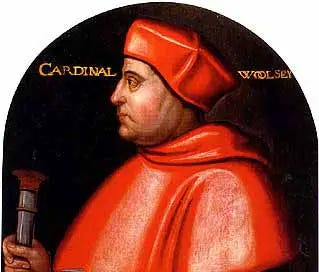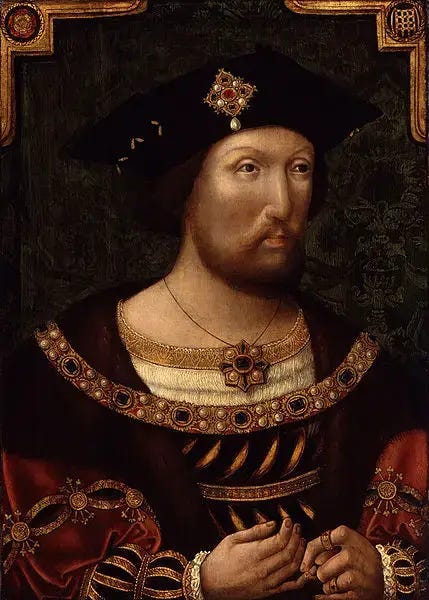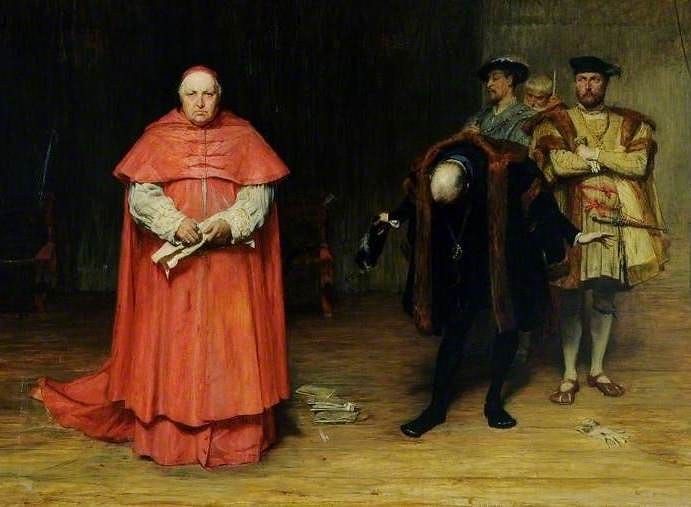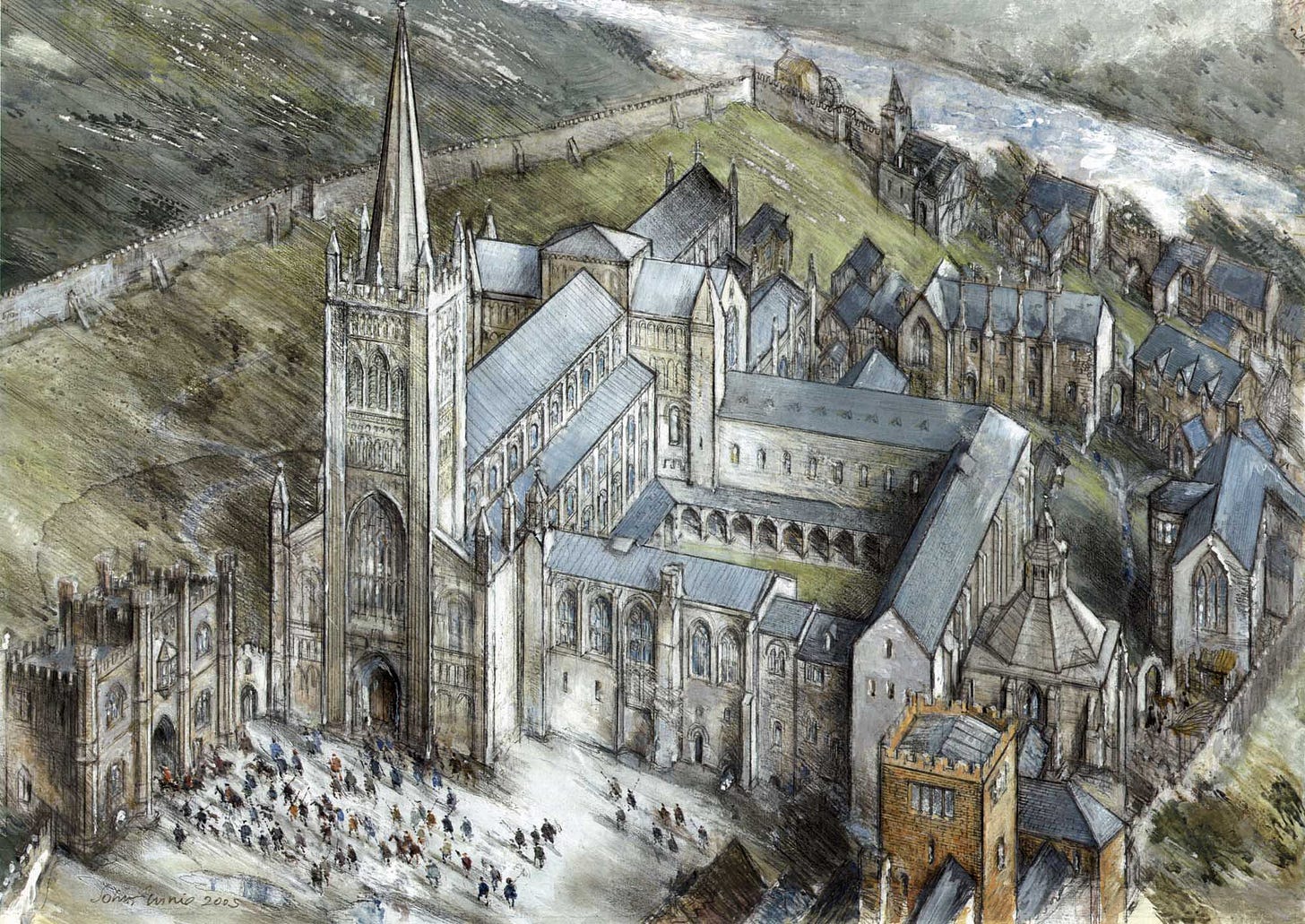On this day, November 29, 1530, Cardinal Thomas Wolsey died en route to the Tower of London at Leicester Abbey.
Cardinal Wolsey is a fascinating figure in Henry VIII’s reign, and, of course, he was central to the attempt of Henry VIII to annul his wife, Catherine of Aragon.
Born in Ipswich, Suffolk, England, Thomas Wolsey received a good education, graduating from Magdalen College, Oxford, at the age of 15. He was ordained as a priest 10 March 1498 and taught at the school. In October 1500, Thomas Grey, 1st Marquis of Dorset, father of a few of Wolsey’s pupils, presented him the rectory of Limington in Somerset. Soon, Wolsey became a chaplain to the Archbishop of Canterbury, Henry Deane.
At the death of the Archbishop in 1503, Wolsey became chaplain to Sir Richard Nanfan, deputy lieutenant of Calais. Nanfan, realizing Wolsey’s intelligence, entrusted him with his financial affairs as well as recommending him to the king, Henry VII. When Nanfan died in 1507, Fr. Wolsey became a chaplain to the king himself. He befriended the influential Bishop of Winchester, Richard Fox, and shortly afterwards acquired livings in Suffolk and Sussex. On February 2, 1509, he had been appointed dean of Lincoln, and he went on a trip to Emperor Maximilan’s court at Flanders on a diplomatic mission. Shortly afterwards, on April 21 1509, King Henry VII died and was succeeded by his son, Henry VIII.
Soon after Henry VIII’s ascension, Wolsey was appointed as the king’s official almoner. He gained many offices and within the next few years, including the living at St. Bride’s in London and the registrar for the Order of the Garter. In 1512, he was made dean of Hereford, then in 1513 he was made dean of York. He accompanied the king to France in June 1513. At Henry’s request, Wolsey was there appointed as Bishop of Tournai by the Pope. He never obtained possession of the bishopric and gave it up for a pension soon after; instead, he became the Bishop of Lincoln, being consecrated at Lambeth on 26 March 1514.
Not long after, in September 1515, he succeeded Cardinal Bainbridge as the Archbishop of York, and on the 10th of September he was officially made a Cardinal by the Catholic Church. On 24 December of that same year, he became Henry VIII’s Lord Chancellor of England. Therefore, by the time he was in his perhaps early forties he was the second highest man in hierarchy of the Catholic Church in England as well as the top man in Henry VIII’s government.
Pausing to look at it all at once… in 1500, as a college professor, he was given the chance to lead a local village church in Somerset. By the end of 1515, he was not only the Archbishop of York (the second-highest man in the hierarchy of the Catholic Church in England) but also Lord Chancellor, the top man in Henry VIII’s government. Wolsey would’ve been in his early forties by this point. Even just looking up until that point in his life, it is an astounding scope of his achievements and the ambition and talent he must’ve had.
As Henry VIII’s Chancellor, Wolsey had the incredibly difficult job of running the country for the king. Wolsey also had the important appointment of being a papal legate, meaning he could make general decisions on behalf of the Pope. As Chancellor and legate, he had to play international politics in a way that would please his king and please the Church as well as advance his country. He had to deal with Henry VIII’s flip-flopping feelings towards the French and the Spanish/Hapsburgs, all the while striving to make England an equal power to them in Europe.
Eventually comes the famous story of Henry VIII falling for Anne Boleyn and seeking to annul his marriage to the Queen, Catherine of Aragon. As papal legate, Henry VIII requested Wolsey get his divorce for him. Try as he might, he would end up failing. He formed a secret ecclesiastical court on May 17, 1527, to try and decide on the annulment, but the court eventually decided that only the Pope himself had that authority. Wolsey tried to get the French King, Francis I, to use his influence on the Pope, as there was the incredible difficulty that the Queen was aunt to the Holy Roman Emperor, Charles V of Spain. In short, the Pope soon became a prisoner of Charles V, and obviously therefore refused to grant the annulment.
However, by April 1528, the Pope agreed to send another papal legate, Cardinal Campeggio, to England to try the case with Wolsey. However, the entire case was in Campeggio’s hands, who seems to have been instructed to stall as much as possible. The trial was finally held on 31 May, 1529, and it failed, much to Wolsey’s humiliation and disgrace. In July, the Pope formally closed the legatine court.
In November 1529, a bill of indictment was set against Wolsey, and on the 19th of November he was ordered to surrender the Great Seal of England as he was no longer to be Chancellor. On November 22, Wolsey was forced to sign a confession that he had committed an offense against the Crown and was therefore stripped of all lands, goods, and offices. In February 1530, after letters of kindness from the king throughout winter, Wolsey received a general pardon and was restored to the Archbishopric of York. However, the cardinal’s enemies at court afterwards convinced the king that he was conspiring to regain his Chancellorship. Therefore, on November 4, 1530, from his seat at Caewood Castle near York, Wolsey was charged with treason for apparently conspiring for a rapprochement with Catherine of Aragon, Charles V, and Rome. He was to make his way to London to face the king.
However, Wolsey had been ill for some time, and very weak. He died from dysentery while on his journey to London, at Leicester Abbey, probably cheating the axeman!
Note: Leicester Abbey was destroyed in 1558 during Henry VIII’s Dissolution of the Monasteries.
Thanks for reading! Don’t forget to like, comment, subscribe, and share if you enjoy my work!
Sources for this post:
https://www.theanneboleynfiles.com/tag/cardinal-wolsey/
https://www.theanneboleynfiles.com/november-4-cardinal-wolsey-is-arrested/
https://www.theanneboleynfiles.com/november-29-cardinal-wolsey-dies-and-not-by-suicide/
https://www.britannica.com/biography/Thomas-Cardinal-Wolsey
https://cardinals.fiu.edu/bios1515.htm
https://www.newadvent.org/cathen/15685a.htm
https://www.bbc.co.uk/history/historic_figures/wolsey_thomas.shtml
https://englishhistory.net/tudor/cardinal-thomas-wolsey-death/
https://publicdomainreview.org/essay/iconology-of-a-cardinal-was-wolsey-really-so-large/
https://www.tudorsociety.com/the-physical-decline-of-henry-viii-by-sarah-bryson/#google_vignette







